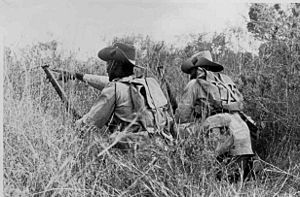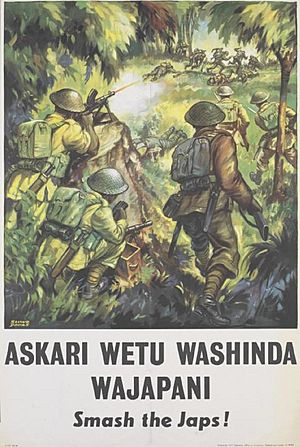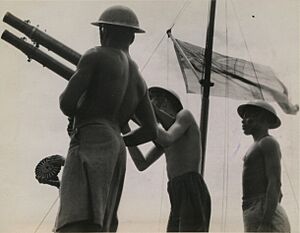Kenya in World War II facts for kids
When World War II started in September 1939, the British colony of Kenya became involved. This happened because the British Empire, which ruled Kenya, declared war on Nazi Germany.
Even though there was some fighting with Italian soldiers in Kenya from June 1940 to February 1941, Kenya was very important to the Allies. It provided valuable resources and many soldiers for the British Army.
Contents
Kenya Prepares for War
Kenya shared a border with Italian East Africa to the north. At the start of the war, people worried that the much larger Italian army would invade Kenya. This had already happened in British Somaliland.
The King's African Rifles (KAR) were in charge of defending British-controlled East Africa. In 1939, they only had about 2,900 soldiers. In contrast, the Italian army in the area had 250,000 colonial troops.
A severe drought in 1939–40 caused crops to fail. This period was known as the "Famine of the Italian." It encouraged many Kenyans, especially from the Akamba farming community, to join the army. People in the colony who were from enemy countries were held or watched closely.
Italian Attacks on Kenya
The big invasion that people feared did not happen. However, smaller Italian attacks did occur in Kenya, similar to those against Sudan. In the summer of 1940, Commonwealth forces and Italy fought in Kenya. The first action of the East African Campaign was when Italian planes bombed the air base at Wajir on June 13.
Italian troops moved from Ethiopia into Moyale and captured "Fort Harrington" after tough fighting. By the end of July, they had moved almost 100 kilometers into Kenya. They took over Buna and Dabel. The Italians stopped their advance because they had trouble getting supplies. These areas stayed under Italian control until February 1941. They were freed during the Allied push into Italian East Africa.
Italian reports from July 1940 stated that their troops had advanced into Kenya. They cut off a 300-kilometer section of the border with Somalia. They also mentioned that local people, like the Daasanach tribe, helped them defeat an enemy attack near Lake Rodolfo.
On September 6, 1940, near Liboi, Italian irregular troops and colonial infantry attacked a British column. This was the first time South African ground troops fought in World War II. Later, British troops attacked the Somali-Kenyan village of El Wak, but they were not successful.
Buna is remembered as the furthest point the Italian Army reached into Kenya during the war. The town was taken in July 1940. An Italian army group, mostly made up of Somalis, stayed there until January 1941.
Malindi was one of only two large towns in Kenya bombed by Italian airplanes. This happened on October 24, 1940, when the port of Malindi was damaged. After this, Allied troops were stationed in the town for the rest of the war.
After a successful attack by the 1st South African Infantry Brigade at another El Wak border post on December 16, 1940, Lieutenant-General Alan Cunningham ordered a full attack on the Italians in eastern Kenya. In late January 1941, two South African brigades attacked Italian-controlled areas in Kenya from Marsabit.
Before moving into southern Abyssinia (now Ethiopia), General George Brink needed to protect his army's side. He also wanted to stop the Italians from getting water. So, on January 16, South African forces attacked water wells at "El Yibo" and "El Sardu." After four days of hard fighting, the Italians had to leave these wells. With the only water sources in South African hands, the advance into Abyssinia could begin.
On February 18, Commonwealth forces entered southern Ethiopia. They captured the fort-city of Mega. Two South African brigades then attacked the area from two sides. This battle lasted three days. Many South African soldiers, who were ready for hot weather, suffered from heavy rains and freezing temperatures.
However, west of Lake Rudolf, the 25th East African Brigade tried to take the town of Kalam near the Ethiopia-Kenya border. Local pro-Italian Merille tribesmen fought so fiercely that the Brigade had to stop its advance and defend itself.
Finally, Moyale, about 70 miles southeast of Mega on the border, was taken on February 22. This was done by a group of Abyssinian irregular troops working with the South African Division. Meanwhile, on January 24, General Cunningham's main force invaded Italian Somaliland from coastal Kenya.
Kenya's Military Role


During the war, Kenya was one of the most important places for the British Army to find new soldiers in Africa. Almost 100,000 Kenyans joined the King's African Rifles as Askaris. This was 30% of the unit's total strength. Most of these soldiers were black Kenyans and volunteers.
However, the King's African Rifles had rules about racial segregation. This meant that white officers and NCOs commanded the units. Black soldiers could not rise above the rank of warrant officer. Kenyan soldiers fought in the successful East African Campaign against the Italians. They also took part in the invasion of Madagascar and the Burma Campaign against the Japanese. Some Kenyans also served in the Royal Navy and the Royal Air Force.
Nigel Gray Leakey, a white NCO from Kenya, was given the Victoria Cross after his death for his bravery in East Africa. This is a very high award for courage.
In 1942, the entire British Eastern Fleet (a large group of warships) moved to Kilindini Harbour near Mombasa in Kenya. This happened because their base in Ceylon was threatened by the Japanese. The Far East Combined Bureau, a secret British codebreaking center, also moved to Kilindini in 1942. There, they worked on breaking Japanese naval codes.
Kenya also gave its name to a British warship, though the ship's crew did not come directly from Kenya.
Kenya's Economic Help
Kenya was a key source of farm products for the British Empire. It supplied large amounts of tea and tobacco. Traditionally, white farmers controlled the Kenyan highlands, where most of the farming happened.
Because more farm products were needed during the war, the colonial government ordered 200,000 Kenyan workers to live and work on white-owned farms. They stayed there until the war ended in 1945.
Prisoner Camps in Kenya
Many Italian soldiers captured during the East African Campaign were held in camps in Kenya. They worked on building roads and other projects. One famous Italian writer, Felice Benuzzi, was held in Kenya. In 1943, he tried to escape by climbing Mount Kenya. He later gave himself up to the British. He wrote about his adventure in his popular book, No Picnic on Mount Kenya.
What Happened After the War
The war caused many changes in Kenya. More people moved to cities like Mombasa and Nairobi, making their populations grow by as much as 50%.
Kenyan soldiers who came home after the war were less willing to accept the unfair treatment they faced before. They also found it hard to find jobs, as they were competing with Indian migrants. Many soldiers were not much better off than before the war.
When the ban on political groups was lifted in 1944, the Kenya African Study Union (KASU) was formed. This was a political party that wanted Kenya to be independent from Britain. It also wanted a country where all ethnic groups were equal. While few soldiers joined the party, many were active in the movement for independence. This movement later led to the Mau Mau Uprising in 1952.
|




